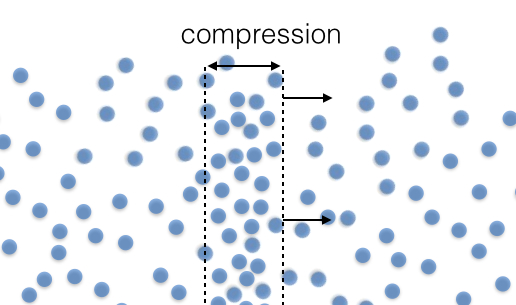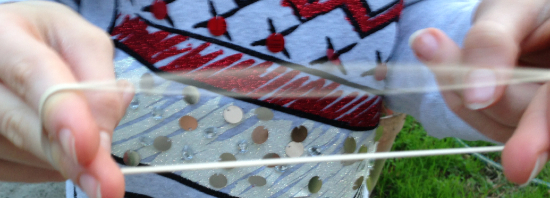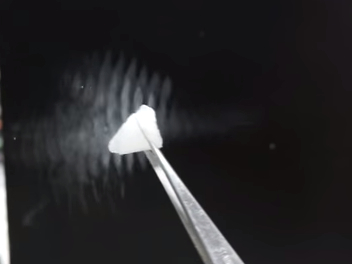This is a very popular video on the internet right now. It shows this awesome set up that uses sound to levitate very low density and small objects. I think this is a great opportunity to talk about sound and forces.
What Is Sound? ————–
I am aiming for a simple explanation here. In fact, sound can be very complicated. So, let's consider sound in air. First, what is air? We can model air as though it were a collection of really tiny balls. In this case, the tiny balls are actually nitrogen molecules (N2) and some oxygen molecules (O2) but I will just assume they are just "air balls" for now.
These air balls are influenced by two things. First, there is the gravitational force. If it were only this one force, each air ball would be like a tiny little projectile motion problem. However, it's not just gravity. There are also interactions between different air balls as they "collide" with each other. How fast are these balls moving? Well, they are all different speeds in every different direction but you could say they have an average speed around 500 m/s.
What about sound? In short, sound is a moving compression in these air balls. The best way to visualize this is to think of a slinky on the ground. If you take this slinky and quickly push one end towards the other, this will create a compression in the slinky that travels down the length of the slinky. Sound is just like this except that is air balls and not a slinky (and you can't really see it).
Here is my attempt to illustrate a compression sound wave in air. Of course this isn't to scale, but hopefully you will get the idea.

Real sound isn't just compressions in the air but also rarefactions. A rarefaction is a region of decreased pressure in the air where the air balls are farther apart than usual.
How fast does this compression of air balls travel? It travels at the speed of sound because this is sound - around 340 m/s. But notice that the compression is traveling in this one direction. The individual air balls are mostly moving faster and in all different directions.
It is a commonly held idea that sound makes the air travel out like a fan. This can be seen in the classic 1978 Maxwell ad that shows a guy's hair blown back due to some rockin speakers. In my usual fashion, I have made a stick figure version of this image.

Sound isn't shooting out air balls, but there is something else important. When these air balls are compressed, they create a region of higher pressure. In fact, you could say that sound is a pressure wave where the region of pressure moves along at the speed of sound.
There is a relationship between the intensity of sound in decibels and the magnitude of the pressure wave. You probably don't want to see this, but here it is.

Why is intensity related to the log of the ratio of pressures? This is because of the way the human ear hears things. The point is that there is a relationship between pressure and hearing. Yes, we will talk about pressure in just a bit.
What Is a Standing Wave? ————————
Since sound is a wave, what happens when you have two waves? If a compression and a rarefaction overlap, they can cancel and make just normal plain air. If two compressions meet at the same time (and place) they can make a region with even higher pressure differences. We call this superposition. If I draw two waves as transverse waves (like a wave on a string) then they would add together like this:
Two waves passing each other is not as simple as the above graph. The graph shows the displacement vs. position. However, the two waves would be changing with time also. These two waves are like ships passing in the night. However, there is a way to combine two waves such that we get something called a standing wave. In a standing wave, there are locations in space with no displacements as time goes on. We call these locations nodes.
You can make your own standing wave fairly easily. Just stretch a rubber band and then pluck it. It will look lik this.

In this rubber band, you have a wave that is traveling back and forth between the two fingers (it reflects when it hits the end). The wave then interferes with itself so that there is a node at both fingers and an oscillating part (anti-node) in the middle. If you play around with this rubber band for a while, you might even be able to pluck it so you get a node in the middle too. But that's a standing wave.
How Do You Float on Sound? ————————–
Now let's levitate some stuff. I might be wrong, but it seems as simple as the following:
- Set up a standing wave. This means that the pressure compressions are stationary in space.
- Place an object such that the pressure below the object is greater than the pressure below it. This means there will be a net upward force. It's just like floating on water except that it's not water. How does increased pressure make something float? Using the air ball model, higher pressure means more balls with more collisions with the object. These collisions exert a force that we call the buoyancy force. Here is an older post that goes over this in more detail.
- Make sure the object isn't so big that it extends into another pressure compression area (that could exert a downward force).
That's it. Levitating stuff. The one in the video is even more awesome than just plain sound levitation. It has some adjustable arrays so that these the standing waves of sound can be moved. This can then move the levitating object. It's so cool I just want to scream, but I won't because you wouldn't hear me anyway.
In this shot from the video, they used dry ice so that you can see the location and size of the standing waves.

There is an arXiv.org paper with more details on this particular levitation device. It says that the pressure difference can levitate object with a density of around 1,000 kg/m3. So, could a human be floated? Probably not. The device uses ultrasonic sound with a frequency of around 40 kHz. This would give a distance between anti-nodes at around 8 millimeters. Humans are bigger than 8 millimeters so they wouldn't be able to fit between anti-nodes. Could you use a longer wavelength? Maybe. You can consider that your homework question. What frequency and what intensity would you need to levitate a human. You can make some approximations - just get a rough estimate.
Ok, I feel like that homework question might be a little difficult. Let me give you some hints.
- First, just treat the standing sound wave as a square wave. Don't worry about the pressure gradient. This means you can just consider the maximum pressure and relate that to the intensity (in decibels). The intensity is a good measure of the "loudness." HyperPhysics has a nice page on intensity and pressure.
- Use ideas of pressure and floating to find the pressure below a levitating human. You can assume a human is a cube if you like.
- Use this pressure to find the intensity.
- Don't forget about wavelength.
- Wikipedia has a nice page listing different things with their sound pressure level. That will be useful for a comparison.
Remember, these are just estimations. You should not use your homework calculations to be a real human levitation machine.
https://www.wired.com/2014/01/how-do-you-levitate-things-with-sound/